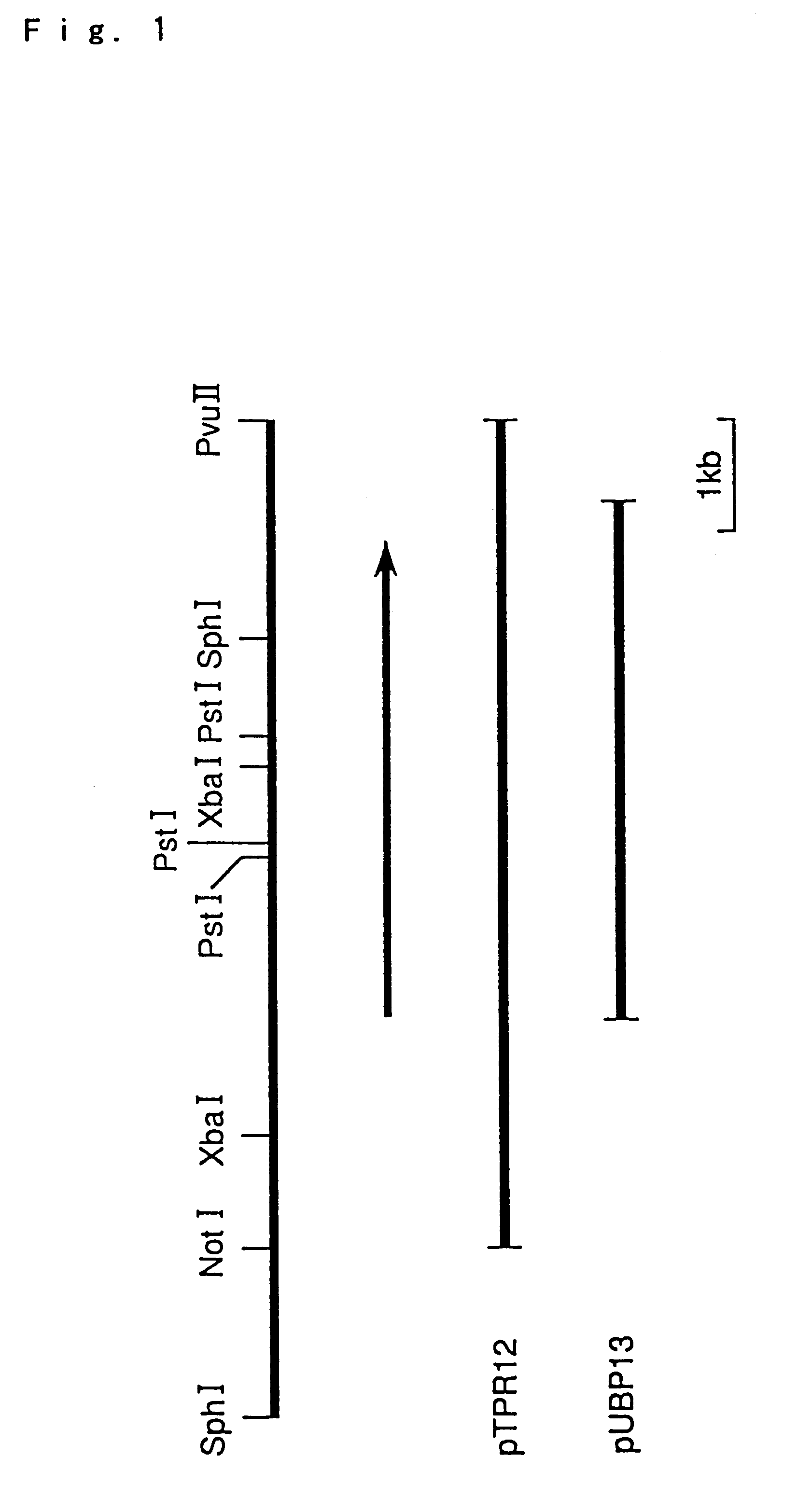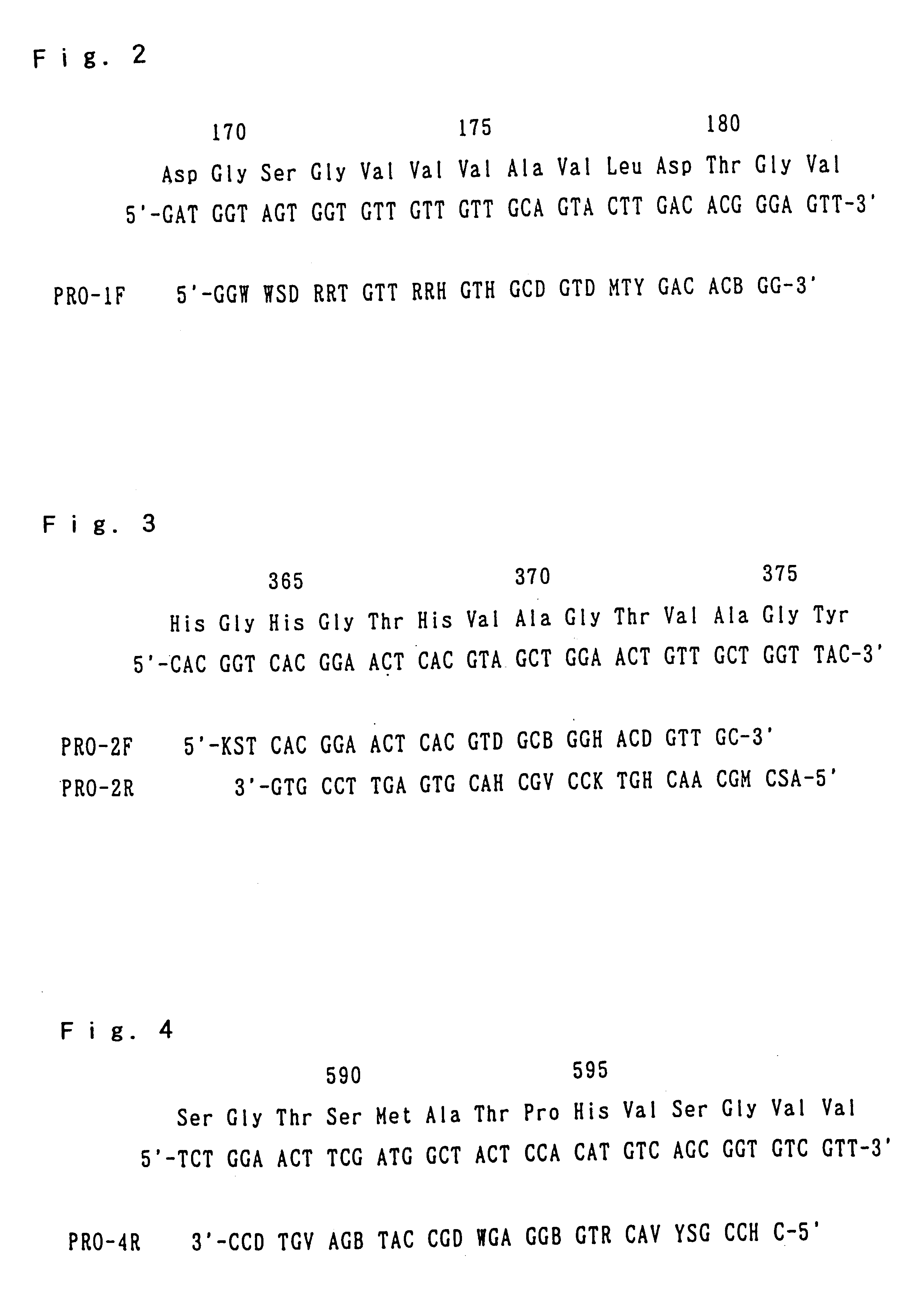Ultrathermostable protease genes
- Summary
- Abstract
- Description
- Claims
- Application Information
AI Technical Summary
Benefits of technology
Problems solved by technology
Method used
Image
Examples
example 1
(1) Preparation of oligonucleotide for detection of hyperthermostable protease gene
By comparing the amino sequence of the protease PFUL represented by SEQ ID No. 8 of the Sequence Listing with those of alkaline serine proteases derived from the known bacterium, the homologous amino acid sequences common to them proved to exist. Among them, three regions were selected and the oligonucleotides were designed, which were used as primers for PCR to detect hyperthermostable protease genes.
FIGS. 2, 3 and 4 show the relationship among the amino acid sequences corresponding to the above three regions of the protease PFUL, the nucleotide sequences of the protease PFUL gene encoding the regions, and the nucleotide sequences of the oligonucleotides PRO-1F, PRO-2F, PRO-2R and PRO-4R synthesized based thereon. SEQ ID Nos. 9, 10, 11 and 12 show the nucleotide sequences of the oligonucleotides PRO-1F, PRO-2F, PRO-2R and PRO-4R, respectively.
(2) Preparation of chromosomal DNA of Thermococcus celer
10...
example 2
(1) Preparation of chromosomal DNA of Pyrococcus furiosus
Pyrococcus furiosus DMS3638 was cultured as follows. A medium having the composition of 1% trypton, 0.5% yeast extract, 1% soluble starch, 3.5% Jamarin S.ANG.Solid (manufactured by Jamarin Laboratory), 0.5% Jamarin S.ANG.Liquid (manufactured by Jamarin Laboratory), 0.003% MgSO.sub.4, 0.001% NaCl, 0.0001% FeSO.sub.4 .ANG.7 H.sub.2 O, 0.0001% COSO.sub.4 , 0.0001% CaCl.sub.2 .ANG.7 H.sub.2 O, 0.0001% ZnSO.sub.4, 0.1 ppm CuSO.sub.4 .ANG.5 H.sub.2 O, 0.1 ppm H.sub.3 BO.sub.3, 0.1 ppm KAl(SO4)2, 0.1 ppm Na.sub.2 MoO.sub.4 .ANG.2 H.sub.2 O, 0.25 ppm NiCl.sub.2 .ANG.H.sub.2 O was placed in a 2 liter medium bottle, and was sterilized at 120.degree. C. for 20 minutes, nitrogen gas was blown into the medium to purge out the dissolved oxygen, and the above bacterial strain was inoculated into the medium, followed by subjecting to stationarily culture at 95.degree. C. for 16 hours. After the completion of cultivation, the cells were collec...
example 3
(1) Preparation of probe for detecting hyperthermostable protease gene The plasmid pTPR12 containing the protease PFUL gene was digested with BalI and HincII (both manufactured by Takara Shuzo Co., Ltd.), which was subjected to 1% agarose gel electrophoresis to recover the separated about 1 kb DNA fragment. A .sup.32 P-labeled DNA probe was prepared using the DNA fragment as a template and using BcaBEST DNA labeling kit and [.alpha.-32P] dCTP.
(2) Detection of hyperthermostable protease gene present in hyperthermophile Staphylothermus marinus and Thermobacteroides proteoliticus
Chromosomal DNAs were prepared from each 10 ml of cultures of Staphylothermus marinus DSM3639 and Thermobacteroides proteoliticus DSM5265 obtained from Deutsche Sammlung von Mikroorganismen und Zellkulturen GmbH according to the procedures described in Example 1-(3). Both chromosomal DNAs were digested with EcoRI, PstI, HindIII, XbaI and SacI, respectively, which were subjected to 1% agarose gel electrophoresis...
PUM
| Property | Measurement | Unit |
|---|---|---|
| Fraction | aaaaa | aaaaa |
| Fraction | aaaaa | aaaaa |
| Fraction | aaaaa | aaaaa |
Abstract
Description
Claims
Application Information
 Login to View More
Login to View More - R&D
- Intellectual Property
- Life Sciences
- Materials
- Tech Scout
- Unparalleled Data Quality
- Higher Quality Content
- 60% Fewer Hallucinations
Browse by: Latest US Patents, China's latest patents, Technical Efficacy Thesaurus, Application Domain, Technology Topic, Popular Technical Reports.
© 2025 PatSnap. All rights reserved.Legal|Privacy policy|Modern Slavery Act Transparency Statement|Sitemap|About US| Contact US: help@patsnap.com



